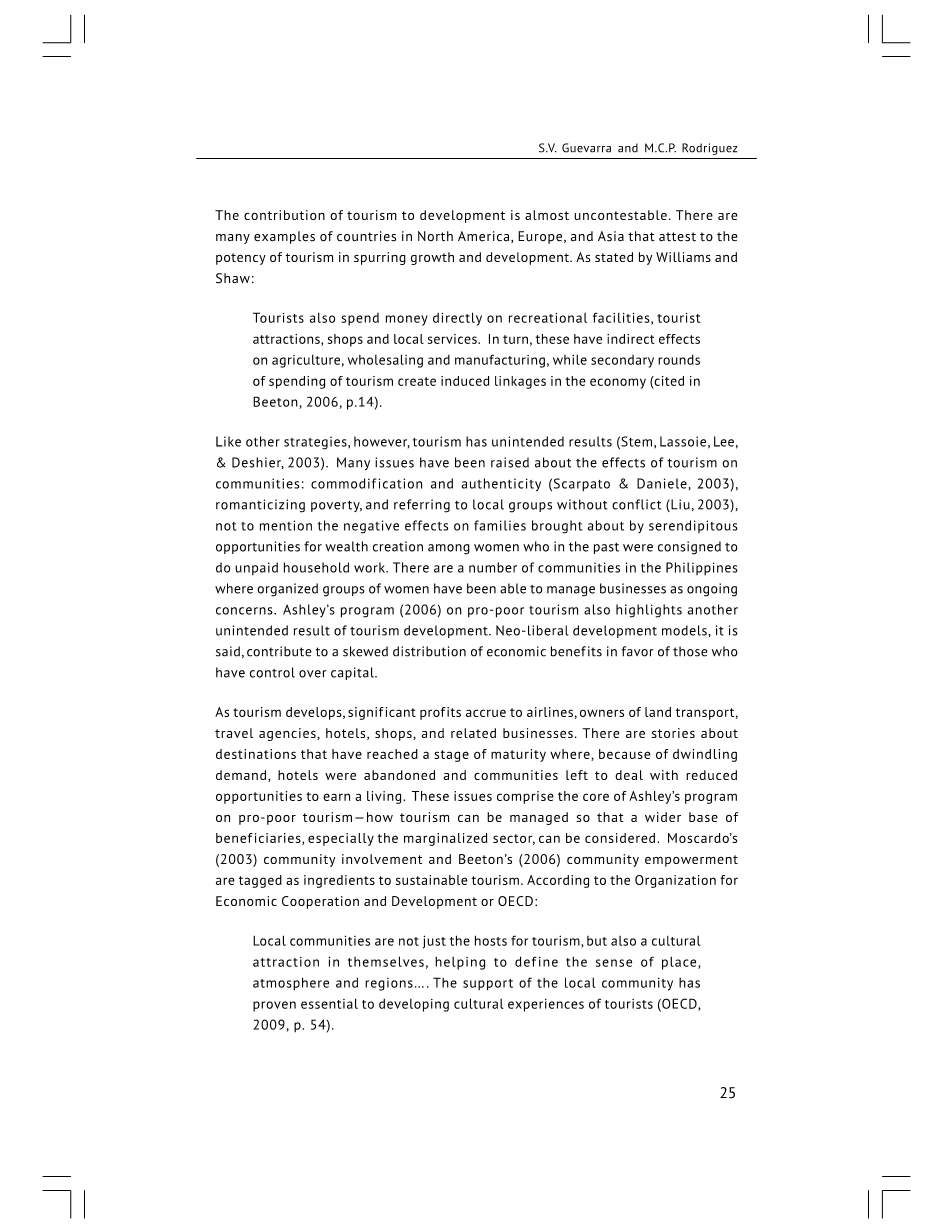

英语原文共 18 页,剩余内容已隐藏,支付完成后下载完整资料
附录A 译文
菲律宾市镇的民宿和旅游业:可持续发展的概念框架
民宿
与商业住宿设施相比,民宿由于相对可以接受的价格,为游客和旅行者提供了替代的住宿选择。在20世纪80年代早期,UP亚洲旅游研究所(AIT)提出了一个民宿计划,后来该计划于1986年被旅游部(DOT) 采用并实施于不同的社区。旅游部最初的民宿计划是让菲律宾和外国游客在菲律宾选定的地区入住当地家庭,为其提供住宿和家庭烹饪的食物。它设想的是为预算有限的菲律宾和外国游客提供住宿机会,当游客和当地经济需要经济实惠的住宿时,民宿家庭就向游客开放。旅游部根据这个计划就举办过一些能力建设培训研讨会,例如1986年10月14日至16日在圣若瑟德安蒂克教区为108名参与者安排了为期两天半的基础住宿流程(根据旅游部1986年11月的记录)。这些活动的参与者来自安蒂克、阿克兰、马林杜克、北三宝护、巴丹和卡坦端内斯。有份报告显示1988年11月5日至6日在碧瑶市为吕宋集群举办了类似的研讨会。旅游部举办了这些研讨会,提供清洁和妥善管理的家庭,以确保该项目的可持续性。没有文献表明,合作社是家庭住宿的经营者,或是在政府的激励机制下创建的。在征税方面,只有政府认可的民宿经营者,比如北吕宋岛的Pagudpud,才有望纳税。但不可否认的是,许多经营者是在没有政府执照的情况下开展经营。
目前,旅游部根据客房需求、设施质量、旅游景点的位置、可达性以及房主为旅行者提供基本食宿的意愿和能力对民宿进行认证。这一整套流程都是仿照旅馆住宿加早餐的模式设计的。
2009年在萨里亚参加过民宿家庭体验的学生们的心得体会中,讲述了游客在民宿体验到了民宿家庭的热情好客,这是酒店和其他商业住宿中所没有的。萨里亚当地家庭在采访中,也表明了他们愿意与陌生人分享他们的家,尤其是在节日期间。
到目前为止,已经有大量社区提供民宿服务。2009年以“针对工作伙伴关系在地方的实施和积极实践”为主题的国际会议(东亚海洋大会,2009年)宣传了一些马尼拉北部(伊洛科斯)成功故事的寄宿家庭项目。这些都是地方政府部门的成功案例,它们在民宿项目的持续运作中发挥了重要作用。菲律宾的长滩岛和Pagudpud,这两个著名的海滩胜地上,也有家庭住宿项目。旅游部列出了民宿家庭的基本标准如下:安全有序的环境,民宿家庭应该能够提供一个独立的房间,房间干净舒适,有干净的床单和被褥,以及充足的饮用水。背包客或预算有限的游客通常会选择民宿家庭。Sariaya地区的酒店价格从1500到8500比索不等,民宿为这群游客提供了替代住宿。
民宿计划的基本特点
民宿项目要求家庭接待一名或多名游客,提供房间给游客住宿,并允许他们使用公共区域,如卫生间、厨房、餐厅和客厅。一个房间可能有的最基本的设施包括床,边桌或咖啡桌,椅子,电话,电扇或空调。民宿计划为寄宿家庭提供了额外收入,通常认为是闲置的房间转换成了创收空间。就设计而言,民宿中有一个独立的门是理想的,这样客人就能保护隐私,他可以在白天和晚上的任何时候进出他的房间。付款金额都是提前确定好的,客人可能会需要额外的床单、枕头和毯子。饮食包括早、中、晚三餐,都是用当地的食材烹制而成,也是展示民宿服务中的一部分。在Sariaya,逐渐出现了城市居民对当地食物和参加饮用当地椰子酒等仪式的需求。
扶贫旅游、社区授权和民宿家庭项目
本文基于以下几种概念研究。
首先,关于“收入漏洞”的管理概念来自Ashley(2006)关于扶贫旅游的材料。她认为民宿计划是把从游客身上获利的机会保留在了社区,她指出了旅游业有利于扶贫的因素:供应链、为弱势群体赚钱项目提供资金、能力建设和制度联系。Ashley所描述的供应链和漏洞指的是旅游目的地通常会出现酒店价格的昂贵、餐馆和商店销售进口商品的情况,是对目的地的资本密集型的资源开发导致了这样的情况。这类公司的扩散导致了“收入流失”,而这种“收入流失”通常不会让当地人受益。因此,民宿可以被认为是一种限制目的地内旅游活动的收入的方法,预计会使利益相关者之间增加成倍的效应。
其他关于社区参与和授权的概念来自Mowforth和Munt(2003)、OECD(2009)、Moscardo(2007)和Beeton(2006)。后者的作者指出,对于“文化饥渴”游客出现了一个新的细分市场。
附录B 外文原文
Homestay and Tourism
in a Philippine Municipality:
A Conceptual Framework for Sustainability
Homestay
Homestay provides alternative accommodation facilities for tourists and travelers at affordable rates compared to commercial lodging facilities. In the early 1980s, the UP Asian Institute of Tourism (AIT) conceptualized a homestay program that was later adopted by the Department of Tourism (DOT) for implementation in different communities in 1986. The DOTrsquo;s homestay program was initially geared toward providing alternative accommodation and home-cooked food to Filipino and foreign tourists by involving local homes in selected homestay areas in the Philippines. It was envisioned to provide opportunities to both Filipino and foreign tourists who travel on a limited budget. Homestays are opened to tourists where there is a demand for affordable accommodation to travelers and local economy. DOT capability-building training-workshops were held, such as the two-and-a-halfday Basic Innkeeping Procedures for 108 participants on October 14 to16, 1986 in San Jose, Antique (Ministry of Tourism Memo, November 1986). Participants came from Antique, Aklan, Marinduque, Zamboanga del Norte, Batanes, and Catanduanes. A report showed that a similar workshop for Luzon cluster followed on November 5 to 6, 1988 in Baguio City. The DOT conducted these seminars to ensure the sustainability of the program in terms of providing clean and properly managed homes. No recorded literature showed the creation of cooperation among homeowners who operate homestay facilities or any government incentives. In terms of tax levy, only government-accredited homestay operators, like in Pagudpud in Northern Luzon, are expected to pay their taxes. It cannot be denied, however, that many operate without a government license.
At present, DOT accredits homestays based on demand for rooms, quality of facilities,presence of tourist attractions, accessibility, and the willingness and ability of homeowners to provide basic food and accommodation for travellers. This whole package was patterned after the bed-and-breakfast model.
Reflection papers written by students who participated in a homestay experience in Sariaya in 2009 stated that homestays enable tourists to experience the hospitality of host families which is absent in hotels and other commercial lodging facilities. Interviews with local families in Sariaya manifest the willingness of residents to share their homes with strangers especially during festivals.
To date, there are a number of communities that offer homestay services. A homestay program bruited about as a success story north of Manila (in Ilocos) was described in a 2009 international conference with the theme, “Partnerships at Work: Local Implementation and Good Practices” (The East Asian Seas Congress, 2009). These are success stories of local government units that have been instrumental in the sustained operation of homestay programs. Boracay and Pagudpud, two popular beach destinations in the Philippines, are also known to have homestay programs. The DOT lists the basic criteria for homestays as follows: good peace and order situation, and host families should be able to provide a separate room, clean comfort room, clean linens and beddings, and adequate and potable water. Backpackers or tourists with a limited budget usually patronize homestays. With the hotel rates ranging from Php 1,500 to 8,500 in Sariaya, homestays will provide alternative lodging for this group of tourists.
Basic Features of the Homestay Program
The homestay program requires families to host one or more tourists by providing room accommodations and allowing them to use common areas such as the comfort room, kitchen, and dining and living rooms. A room may have the most basic amenities su
剩余内容已隐藏,支付完成后下载完整资料
资料编号:[605564],资料为PDF文档或Word文档,PDF文档可免费转换为Word


